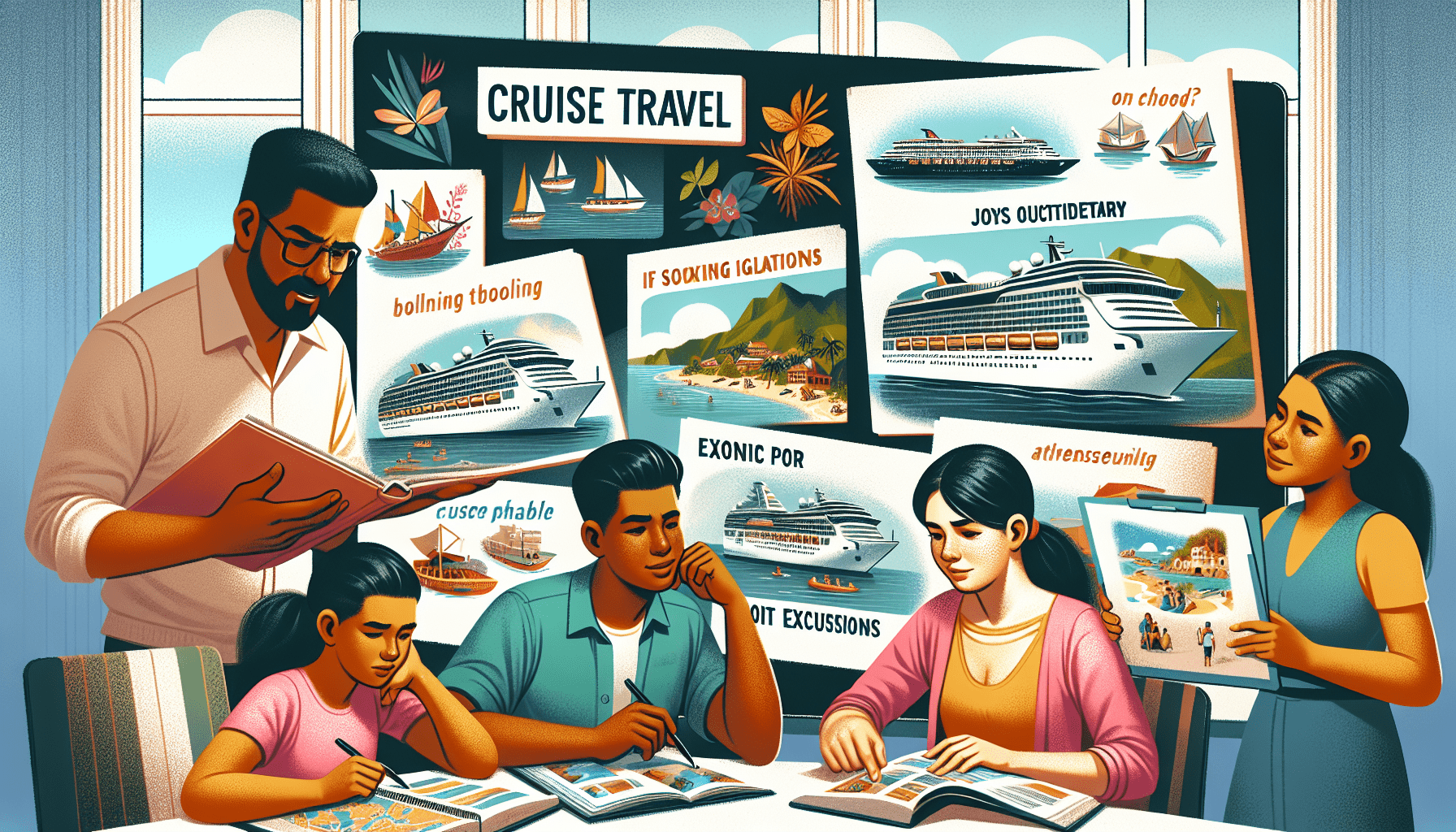Are you ready to set sail on an unforgettable adventure? Look no further than “The Ultimate Guide to Cruise Travel.” This comprehensive article will provide you with all the information you need to know about embarking on a cruise vacation. From selecting the perfect itinerary and ship, to planning shore excursions and making the most of onboard amenities, this guide is your go-to resource for all things cruise travel. So grab your sunscreen and get ready to explore the high seas like never before!

Choosing the Right Cruise
Planning a cruise vacation can be an exciting and enjoyable experience. With so many cruise lines and itineraries to choose from, it’s important to do some research to ensure you choose the right cruise for your preferences and needs.
Researching Different Cruise Lines
The first step in choosing the right cruise is to research different cruise lines. Each cruise line has its own unique personality, atmosphere, and target audience. Some cruise lines are known for their family-friendly environment and amenities, while others cater to adults looking for a more upscale experience.
When researching cruise lines, consider factors such as the size of the ship, types of activities and entertainment offered, dining options, and the level of service provided. Online reviews and travel forums can be helpful resources in gaining insights and opinions from previous cruise travelers.
Considering the Itinerary and Destinations
Next, consider the itinerary and destinations offered by each cruise line. Determine what type of experience you are looking for and choose an itinerary that aligns with your interests. Whether you prefer lounging on white sandy beaches, exploring historical landmarks, or immersing yourself in vibrant cultures, there is a cruise itinerary to suit every traveler.
Also, take into account the duration of the cruise and the number and length of port stops. Some cruises offer a variety of ports, allowing you to explore multiple destinations, while others focus on a specific region or country. Consider whether you prefer a more relaxed pace or a jam-packed itinerary, as this will help you narrow down your options.
Determining the Length of the Cruise
The length of the cruise is an important factor to consider when choosing the right cruise. Cruises can vary in duration, ranging from a few days to several weeks. The duration of the cruise can impact the overall cost, the number of port stops, and the level of relaxation or adventure you desire.
If you are a first-time cruiser or have limited time, a shorter cruise may be ideal to get a taste of the cruising experience. On the other hand, if you have more time and are looking for a more immersive vacation, a longer cruise may be the perfect choice.
Selecting the Best Cabin Type
Finally, selecting the best cabin type for your cruise can greatly enhance your overall experience. Cruise ships offer a range of cabin options, from interior cabins without windows to luxurious suites with private balconies. Consider your budget, desired level of comfort, and preferences for natural light and views when choosing a cabin type.
Interior cabins are typically more affordable and provide a cozy, sleep-friendly atmosphere. Oceanview cabins offer a window or porthole, allowing you to enjoy natural light and scenic views. Balcony cabins provide the added luxury of a private outdoor space, perfect for enjoying the ocean breeze and stunning views. Suites offer spacious accommodations, additional amenities, and personalized service.
By thoroughly researching different cruise lines, considering the itinerary and destinations, determining the length of the cruise, and selecting the best cabin type, you will be well on your way to choosing the right cruise for an unforgettable vacation experience.
Booking Your Cruise
Once you have selected the perfect cruise for your vacation, it’s time to book your trip. Booking a cruise can be done through a travel agent or online. Both options have their advantages, and it’s important to consider factors such as price, convenience, and personalized assistance before making a decision.
Using a Travel Agent vs. Booking Online
Using a travel agent to book your cruise can provide several benefits. Travel agents have in-depth knowledge and expertise when it comes to cruises and can help guide you through the booking process, ensuring you find the best deals and promotions. They can also provide personalized recommendations based on your preferences and offer assistance with any special requests or concerns.
On the other hand, booking your cruise online offers convenience and the ability to compare prices and options from multiple cruise lines. Online platforms often provide detailed information about each cruise line, itinerary, and cabin type, allowing you to make an informed decision. Additionally, online bookings may offer exclusive discounts and promotions that are not available through travel agents.
Ultimately, the choice between using a travel agent or booking online depends on your personal preferences and needs. If you prefer a more hands-on, personalized approach, a travel agent may be the best option. If you enjoy the convenience and flexibility of researching and booking online, then booking directly through a cruise line’s website or a trusted online travel agency is the way to go.
Comparing Prices and Special Deals
When booking your cruise, it’s important to compare prices and special deals to ensure you are getting the best value for your money. Prices can vary significantly depending on factors such as the cruise line, cabin type, itinerary, and time of year.
Check multiple websites and platforms to compare prices and take advantage of any special deals or promotions. Many cruise lines offer discounted rates, free upgrades, onboard credits, or other perks during certain times of the year. Additionally, be on the lookout for exclusive deals offered through travel agents or online travel agencies.
Keep in mind that while price is an important consideration, it should not be the sole determining factor in choosing a cruise. Consider the overall value and what is included in the price, such as meals, accommodations, onboard activities, and entertainment. A slightly higher price may be worth it for a more inclusive and enjoyable experience.
Securing Travel Insurance
Travel insurance is an important aspect of booking a cruise that should not be overlooked. While cruises offer a safe and secure environment, unexpected circumstances can still arise, such as illness, injury, or travel disruptions. Travel insurance provides peace of mind and financial protection in case of unforeseen events.
When choosing travel insurance, consider factors such as coverage for medical expenses, trip cancellation or interruption, lost or delayed baggage, and emergency medical evacuation. Be sure to carefully read and understand the policy, including any exclusions or limitations.
Understanding the Terms and Conditions
Before finalizing your cruise booking, it’s crucial to thoroughly read and understand the terms and conditions. The terms and conditions outline important information such as cancellation policies, refund policies, payment schedules, and restrictions. By familiarizing yourself with these terms, you can avoid any surprises or unexpected fees down the line.
Pay close attention to the cancellation policy, as it can vary depending on the cruise line and time of year. Some cruise lines may offer full refunds or future cruise credits if you cancel within a certain timeframe, while others may have strict cancellation fees. Additionally, take note of any payment deadlines and requirements to ensure a smooth booking process.
By carefully considering whether to use a travel agent or book online, comparing prices and special deals, securing travel insurance, and understanding the terms and conditions, you can confidently book your cruise and look forward to your upcoming vacation.
Preparing for Your Cruise
As your cruise departure date approaches, it’s important to take the necessary steps to prepare for your trip. From checking passport and visa requirements to packing essential items, thoughtful preparation will ensure a smooth and enjoyable cruise experience.
Checking Passport and Visa Requirements
Before embarking on your cruise, it’s crucial to check the passport and visa requirements for your specific itinerary. Some cruises may require a valid passport, while others may accept other forms of identification, such as a birth certificate and government-issued photo ID. It’s important to verify these requirements well in advance to avoid any last-minute complications.
If your cruise involves international ports of call, check if you need a visa for any of the destinations. Some countries require visitors to obtain a visa in advance, while others offer visa-free entry to cruise passengers. Research the specific visa requirements for each port of call and make sure you allow enough time to obtain any necessary visas.
Booking Flights and Transfers
If your cruise departure port is located far from your home, it may be necessary to book flights and transfers to ensure a smooth journey. When booking flights, consider factors such as the timing of your arrival and departure, as well as any potential layovers or connections. It’s recommended to arrive at least one day before your cruise departure to allow time for any unforeseen delays or travel disruptions.
Many cruise lines offer transfer services from the airport to the cruise port, making it convenient and hassle-free. Check if your cruise line offers this service and make the necessary arrangements in advance. Alternatively, you can choose to arrange your own transportation, such as taking a taxi or using a ride-sharing service.
Packing Essentials for Your Cruise
Packing for a cruise requires thoughtful consideration of both the destination and the onboard activities and dress codes. Here are some essential items to pack for your cruise:
- Clothing: Pack a variety of clothing options suitable for different climates and activities. Include comfortable clothing for daytime activities, swimwear, formal wear for elegant evenings, and appropriate attire for any planned excursions.
- Toiletries: Bring essential toiletries such as toothpaste, shampoo, conditioner, and any specific medications or personal care items you may need. While cruise ships often provide these items, it’s always a good idea to have your own supply.
- Travel documents: Don’t forget to pack your passport, visas (if required), boarding passes, and any other necessary travel documents. It’s a good idea to make copies of these documents and keep them in a separate location in case any originals are lost or stolen.
- Electronics and chargers: If you plan to bring electronics such as cameras, phones, or tablets, remember to pack the necessary chargers and adapters. Some cruise ships offer limited outlets, so it may be helpful to bring a power strip or portable charger.
- Comfort and entertainment: Consider bringing items that will enhance your comfort and entertainment during the cruise, such as a travel pillow, books, games, or portable speakers. However, keep in mind that cruise ships offer a wide range of onboard activities and amenities to keep you entertained.
Understanding On-board Dress Codes
Cruise ships often have dress codes for various venues and occasions onboard. Familiarize yourself with these dress codes to ensure you pack appropriate clothing for each event. While some cruise lines have relaxed dress codes, others may have formal nights or specific attire requirements for certain dining venues or shows.
Typical dress codes include casual, smart casual, and formal. Casual attire is suitable for daytime activities and includes items such as shorts, t-shirts, sundresses, and swimwear. Smart casual attire may be required for dining at certain restaurants, and it usually includes slacks or dresses for women and collared shirts and slacks for men. Formal attire is typically reserved for special events or formal nights and may include cocktail dresses or suits and ties.
By checking passport and visa requirements, booking flights and transfers, packing essential items for your cruise, and understanding onboard dress codes, you can adequately prepare for your upcoming cruise adventure.
Embarking on Your Cruise
After months of anticipation, the day you embark on your cruise has arrived. From getting to the port to checking in and exploring the ship’s amenities, here’s what you need to know to start your cruise off on the right foot.
Getting to the Port
The first step in embarking on your cruise is getting to the port of departure. Depending on your location and the cruise port, you may choose to drive, take a taxi, or use public transportation. If you have booked a transfer service through your cruise line, follow the instructions provided to ensure a smooth and hassle-free journey to the port.
It’s advisable to arrive at the port a few hours before the scheduled boarding time, as this allows ample time for check-in procedures and security screenings. Check with your cruise line for any specific arrival times or procedures. Keep any necessary travel documents, such as your passport and boarding passes, easily accessible to facilitate the embarkation process.
Checking In and Boarding the Ship
Once you arrive at the port, the next step is to check in and board the ship. Follow the signs and instructions provided by the port staff to the designated check-in area. Have your necessary travel documents ready for verification, and complete any required forms or health screenings.
After checking in, you will receive your cruise card, which serves as your identification, room key, and onboard payment method. Keep this card with you at all times and ensure it is securely stored when not in use. Once you have completed the check-in process, you will proceed through security screenings before boarding the ship.
Attending Mandatory Safety Drills
Safety drills are a mandatory part of the cruise experience and are conducted prior to the ship’s departure. These drills are designed to familiarize passengers with emergency procedures and ensure everyone knows what to do in the event of an emergency.
The most common safety drill is the muster drill, where passengers gather at assigned assembly stations on the ship. During the drill, crew members explain important safety information, including how to properly don a life jacket and the location of emergency exits. Pay close attention to these instructions and take the drill seriously to ensure your safety and the safety of others onboard.
Exploring the Ship’s Amenities
Once you have completed the mandatory safety drill, it’s time to start exploring the ship’s amenities and settling into your accommodations. Cruise ships offer a wide range of facilities and activities to suit every taste and interest. Take some time to familiarize yourself with the ship’s layout and locate important areas such as the dining venues, pools, fitness center, spa, and entertainment venues.
Check the ship’s daily newsletter or app for a schedule of activities and events taking place throughout the day. Whether you prefer lounging by the pool, attending a fitness class, participating in a trivia contest, or enjoying live music, there is always something to do on a cruise ship. Take advantage of the onboard amenities and make the most of your time at sea.
By getting to the port on time, checking in and boarding the ship smoothly, attending mandatory safety drills, and exploring the ship’s amenities, you can start your cruise vacation off on the right foot and begin to enjoy all the exciting experiences that await you.

Dining and On-board Activities
One of the highlights of a cruise vacation is the diverse dining options and onboard activities available to guests. From indulging in gourmet cuisine to participating in engaging activities, there is something to satisfy every taste and interest.
Understanding the Dining Options
Cruise ships offer a variety of dining options to suit different preferences and culinary desires. The main dining room is typically included in the cruise fare and offers an extensive menu that changes daily. This is a great option for those who prefer a traditional dining experience with formal service and a set dining time.
In addition to the main dining room, cruise ships often feature specialty restaurants that offer a more intimate and upscale dining experience for an additional fee. These restaurants may serve cuisine from around the world, such as Italian, Asian, or steakhouse fare. Reservations are usually required for specialty dining, especially during peak dining hours.
For a more casual dining experience, cruise ships also offer buffet-style restaurants where guests can indulge in a wide variety of dishes. These restaurants typically have extended operating hours, making them ideal for breakfast, lunch, or a late-night snack. Some ships also have themed specialty buffets, such as seafood or international cuisine nights.
Making Specialty Dining Reservations
If you wish to dine at specialty restaurants onboard, it’s advisable to make reservations in advance. Specialty restaurants often have limited seating capacity, and popular venues can fill up quickly, especially on larger ships. Check with your cruise line for information on how and when to make specialty dining reservations.
When making reservations, consider your preferences and the unique dining experiences each restaurant offers. Some specialty restaurants may have outdoor seating options or panoramic views, making them perfect for a romantic dinner or special occasion. Others may offer interactive dining experiences, such as teppanyaki or chef’s table events, where you can witness the culinary creation process firsthand.
Participating in On-board Activities
Cruise ships are known for their wide range of onboard activities and entertainment options. From educational lectures and fitness classes to game shows and live performances, there is something for everyone to enjoy.
Check the daily newsletter or app for a schedule of activities and plan your day accordingly. Participate in a cooking demonstration, attend an art auction, or try your luck at the onboard casino. Join a dance class, take a yoga session, or hit the gym for a workout. Many ships also feature sports courts, mini-golf, rock climbing walls, or even water parks for guests to enjoy.
For those seeking relaxation, indulge in a spa treatment, unwind in a hot tub, or simply find a comfortable spot on deck to soak up the sun and enjoy the ocean views. Many cruise ships also have libraries, card rooms, and quiet lounges where you can relax with a book or socialize with fellow passengers.
Enjoying the Entertainment and Shows
Cruise ships are renowned for their top-notch entertainment and thrilling shows. From Broadway-style productions to comedy shows and live music performances, there is no shortage of exciting entertainment options onboard.
Most cruise lines offer nightly shows in large theaters or show lounges. These shows often feature talented singers, dancers, and acrobats who put on impressive performances filled with music, choreography, and visual effects. Check the daily schedule for showtimes and plan your evening accordingly.
In addition to the main theater productions, cruise ships also offer a variety of other entertainment options. Enjoy live music performances in lounges or at poolside parties, laugh at comedy shows featuring renowned comedians, or test your luck at the onboard casino. Some ships even have interactive game shows or themed parties that provide endless fun and excitement.
By understanding the dining options available onboard, making specialty dining reservations, participating in onboard activities, and enjoying the entertainment and shows, you can make the most of your cruise vacation and create unforgettable memories.
Exploring Ports of Call
One of the highlights of a cruise vacation is the opportunity to explore fascinating ports of call. From researching excursion options to understanding local customs and cultures, here’s how to make the most of your time in each destination.
Researching Excursion Options
When visiting ports of call, it’s important to research excursion options in advance to maximize your time and experience. Excursions include guided tours, cultural experiences, adventure activities, and more. These pre-arranged tours allow you to explore the highlights of each destination with the expertise of local guides.
Research the excursion options offered by your cruise line and consider your interests and preferences. Some popular excursion categories include city tours, historical tours, nature and wildlife experiences, and adventure activities such as snorkeling or zip-lining. Read the descriptions and itineraries carefully, and choose excursions that align with your interests and fitness levels.
Planning Your Day in Port
When planning your day in port, consider the duration of your stay and the proximity of the port to the main attractions. Some ports may require a longer travel time to reach popular sights, while others may have attractions within walking distance. Take into account the time it will take to disembark from the ship and return before the scheduled departure time.
Create a rough itinerary for your day in port, including the sights or activities you wish to prioritize. Be realistic about the number of attractions you can visit in the limited time available and build in some flexibility. It’s a good idea to have a backup plan in case of unforeseen circumstances, such as changes in weather or unexpected closures.
Understanding Local Customs and Cultures
As you explore different ports of call, it’s important to be mindful of local customs and cultures. Research the local customs, traditions, and etiquette of each destination to ensure you show respect and make a positive impression. Understanding and embracing the local customs can greatly enhance your travel experience and help you connect with the local culture.
Learn a few basic phrases in the local language, such as greetings and thank you, as a sign of respect. Familiarize yourself with any dress codes or modesty requirements, especially when visiting religious sites or conservative countries. Respect local traditions and customs, such as removing your shoes before entering someone’s home or refraining from taking photographs in certain areas.
Tips for Safe Exploration
When exploring ports of call, it’s important to prioritize your safety and well-being. Here are some tips for safe exploration:
- Be aware of your surroundings and stay in well-populated, well-lit areas, especially in unfamiliar or isolated locations.
- Keep your belongings secure and avoid displaying valuable items in public.
- Use reliable transportation options, such as authorized taxis or pre-arranged tours.
- Follow the advice and instructions of local authorities and tour guides.
- Stay hydrated and protect yourself from the sun by wearing sunscreen, a hat, and sunglasses.
- Carry a photocopy of your passport and other important documents with you and leave the originals in a secure place onboard the ship.
- Be cautious when interacting with strangers and avoid divulging personal information.
By researching excursion options, planning your day in port, understanding local customs and cultures, and prioritizing your safety, you can make the most of your time in each destination and create unforgettable memories.
See All the Sights With One Pass
Staying Healthy and Safe
Maintaining good health and safety practices while on a cruise is essential to ensure a comfortable and enjoyable vacation. By practicing good hygiene, staying safe on the ship, protecting yourself from the sun, and addressing any seasickness concerns, you can have a worry-free cruise experience.
Practicing Good Hygiene
While cruise ships have stringent cleanliness standards, it’s important to practice good hygiene to minimize the risk of illness. Here are some tips for maintaining good hygiene onboard:
- Wash your hands regularly with soap and water for at least 20 seconds, especially before meals, after using the restroom, and after touching surfaces in public areas.
- Use hand sanitizers that are provided throughout the ship, particularly in high-traffic areas.
- Avoid touching your face, especially your eyes, nose, and mouth, to prevent the transmission of germs.
- Cover your mouth and nose with a tissue or your elbow when coughing or sneezing, and immediately dispose of used tissues in designated receptacles.
- Follow any health and safety guidelines provided by the ship, such as proper handwashing techniques and respiratory etiquette.
Staying Safe on the Ship
Cruise ships are designed to prioritize passenger safety and security. However, it’s important to take some precautions to ensure a safe and secure environment. Here are some tips for staying safe on the ship:
- Familiarize yourself with the ship’s layout and emergency exits. Take note of the location of your cabin and the nearest emergency assembly stations.
- Keep your cabin door locked when you are inside and use the peephole or cabin door viewer to identify visitors before opening the door.
- Store valuable items in the cabin safe or use the ship’s safe deposit boxes for added security.
- Be cautious when walking on wet decks or staircases, as they can be slippery. Use handrails and take your time to prevent accidents.
- Report any suspicious activities, unattended bags, or unfamiliar individuals to ship staff or security personnel.
Protecting Yourself from the Sun
Cruise vacations often involve spending time outdoors, enjoying the sun and beautiful views. However, it’s important to protect yourself from the sun’s harmful rays to prevent sunburn and long-term skin damage. Here are some tips for sun protection:
- Apply a broad-spectrum sunscreen with a high SPF before going outside, and reapply it regularly, especially after swimming or sweating.
- Wear a wide-brimmed hat, sunglasses, and protective clothing, such as long-sleeved shirts and pants, to shield your skin from direct sunlight.
- Seek shade during the sun’s peak hours, generally between 10 a.m. and 2 p.m., when the rays are strongest.
- Stay hydrated by drinking plenty of water, as sun exposure can lead to dehydration.
Dealing with Seasickness
Seasickness, also known as motion sickness, can occasionally affect cruise passengers, especially those who are sensitive to motion. Symptoms may include nausea, dizziness, and vomiting. However, there are measures you can take to prevent or alleviate seasickness:
- Choose a cabin location that minimizes motion, such as a midship cabin or one on a lower deck.
- Keep your eyes on the horizon or a fixed point in the distance to help your brain adjust to the motion.
- Eat small, frequent meals and avoid heavy or greasy foods that can exacerbate nausea.
- Stay hydrated and avoid alcoholic beverages, as they can make symptoms worse.
- Consider using over-the-counter motion sickness medications or remedies, such as wristbands or patches. Consult with your healthcare provider before taking any medication.
By practicing good hygiene, staying safe on the ship, protecting yourself from the sun, and addressing any seasickness concerns, you can ensure a healthy and safe cruise experience.
Managing Finances on Your Cruise
Effective financial management is key to ensuring that you stay within your budget and avoid overspending on your cruise vacation. By setting a budget for onboard expenses, understanding onboard currency and payment methods, avoiding overspending, and managing gratuities and tipping, you can keep your finances in check.
Setting a Budget for On-board Expenses
Before embarking on your cruise, it’s important to set a budget for your onboard expenses. Onboard expenses can include dining at specialty restaurants, purchasing beverages, participating in certain activities, shopping, and any additional services or experiences not included in the cruise fare.
Consider your personal preferences and prioritize the experiences that are most important to you. Determine how much you are willing to spend on dining, drinks, and any optional activities or services. It’s also important to factor in any additional charges, such as gratuities, taxes, or service fees.
Understanding On-board Currency and Payment Methods
Cruise ships operate on a cashless system, where most onboard purchases are made using your cruise card. The cruise card is linked to your onboard account, and charges will be added to your account throughout the cruise. At the end of the cruise, you will settle the final bill using a credit card, cash, or other approved payment methods.
Familiarize yourself with the onboard currency used on your cruise, as it may differ from the local currency at the ports of call. Many cruise lines use US dollars as the onboard currency, while others may have their own onboard credit system. Check with your cruise line for specific details.
Tips for Avoiding Overspending
To avoid overspending on your cruise, consider the following tips:
- Monitor your onboard account regularly throughout the cruise to keep track of your expenses.
- Set spending limits and stick to them. Avoid impulse purchases and carefully consider the value and necessity of each expenditure.
- Take advantage of any inclusive dining options and activities without additional charges to minimize expenses.
- Be cautious when using your cruise card for small purchases, as they can add up quickly. Consider using cash or setting a limit for small transactions.
- Research onboard promotions and package deals that offer discounts or additional benefits for multiple purchases.
- Avoid excessive gambling in the ship’s casino, as it can quickly deplete your budget.
Managing Gratuities and Tipping
Gratuities and tipping are customary on cruise ships to recognize the service provided by the crew members. Most cruise lines have a suggested amount for gratuities, which is typically added to your onboard account automatically. However, check with your cruise line to understand their specific gratuity policy.
If automatic gratuities are included, consider the overall service provided by the crew and adjust the gratuities accordingly. If gratuities are not automatically added, it’s customary to offer tips to the crew members who have provided exceptional service throughout your cruise. Envelopes for cash tips are often provided at the end of the cruise for this purpose.
By setting a budget for onboard expenses, understanding onboard currency and payment methods, avoiding overspending, and managing gratuities and tipping, you can keep your finances under control and enjoy a worry-free cruise vacation.
Staying Connected at Sea
While a cruise vacation offers an opportunity to disconnect and enjoy quality time away from everyday life, staying connected at sea can still be important for various reasons. By understanding onboard internet options, making phone calls and messaging, saving data usage, and using social media on the ship, you can stay connected with friends and family or share your cruise experience with the world.
Understanding On-board Internet Options
Most cruise ships offer onboard internet access, allowing passengers to stay connected while at sea. However, it’s important to note that the internet connection may not be as fast or reliable as what you are accustomed to on land.
Cruise ships provide internet packages that can be purchased for a specified duration or amount of data usage. These packages often come at an additional cost and the price varies depending on the cruise line and the speed and data limits of the package. It’s recommended to purchase the internet package in advance, as prices may be higher onboard.
Making Phone Calls and Messaging
Making phone calls and messaging while on a cruise ship can be more challenging and expensive compared to on land. Cellular service is typically not available while at sea, and using your phone’s roaming capabilities can result in high charges.
Cruise ships offer alternative communication options, such as onboard telephones, internet-based messaging apps, or Wi-Fi calling. Check with your cruise line for specific details and costs. It’s important to note that using these services usually incurs additional fees, so it’s advisable to set a budget or limit for phone and messaging expenses.
Tips for Saving Data Usage
If you choose to use the onboard internet to stay connected, it’s important to be mindful of your data usage to avoid excessive charges. Here are some tips for saving data usage:
- Use Wi-Fi connections whenever available for tasks that do not require high bandwidth, such as checking emails or browsing websites.
- Turn off automatic app updates and disable background app refresh on your devices to minimize unnecessary data usage.
- Avoid streaming videos or downloading large files, as these activities consume significant data.
- Optimize your email settings to sync less frequently or only download headers instead of full messages.
- Disable automatic cloud backups or set them to occur only when connected to a Wi-Fi network.
Using Social Media on the Ship
If you wish to share your cruise experience with friends and family or engage with fellow cruisers, using social media on the ship is a great way to stay connected. Many cruise ships offer onboard Wi-Fi that allows access to popular social media platforms.
Take advantage of this opportunity to share photos, videos, and updates about your cruise adventure. Join cruise-specific groups or forums to connect with other passengers and exchange tips and recommendations. Just be mindful of your data usage and any associated costs, as mentioned earlier.
By understanding onboard internet options, making phone calls and messaging, saving data usage, and using social media on the ship, you can stay connected with your loved ones and capture and share the unforgettable moments of your cruise vacation.
Disembarking and Post-Cruise
As your cruise vacation comes to an end, there are a few important steps to take to ensure a smooth disembarkation process and wrap up your post-cruise arrangements. By preparing for disembarkation, settling final bills and disputes, arranging post-cruise accommodations or travel, and reflecting on your cruise experience, you can conclude your cruise vacation on a positive note.
Preparing for Disembarkation
Disembarkation is the process of leaving the cruise ship at the end of your voyage. Cruise lines have specific procedures and schedules for disembarkation, and it’s important to follow their instructions to ensure an organized and efficient process.
Before disembarking, review the disembarkation information provided by your cruise line. This information may include details about luggage handling, customs procedures, and ground transportation options. Pack your bags the night before, following any specific guidelines or requirements provided by the cruise line, such as tagging your bags with disembarkation tags.
Settling Final Bills and Disputes
Before leaving the ship, settle any outstanding bills or disputes to avoid any last-minute complications. Check your onboard account to ensure its accuracy, reviewing all charges and credits. If you notice any discrepancies or have any concerns, contact the ship’s guest services or billing department immediately.
Most cruise lines provide a final bill the night before disembarkation, which can be settled using your chosen payment method, such as a credit card or cash. Alternatively, you may have the option to provide a pre-authorized credit card or cash deposit at the beginning of the cruise to cover any onboard expenses.
Arranging Post-Cruise Accommodations or Travel
If your cruise ends in a different port from where you embarked or you have arranged a post-cruise extension, it’s important to make necessary arrangements for accommodations or travel. Determine whether you will be staying overnight in the disembarkation port or immediately continuing your journey.
Check with your cruise line or travel agent for recommendations on local accommodations or transportation options. Some cruise lines offer packages that include post-cruise hotel stays or transportation to the airport. Alternatively, you may choose to arrange your own accommodations or transportation based on your preferences and itinerary.
Reflecting on Your Cruise Experience
As you bid farewell to your cruise vacation, take some time to reflect on your experience and create lasting memories. Share your favorite moments with fellow passengers, friends, and family. Consider writing a review or testimonial to provide useful feedback to the cruise line and fellow travelers.
Reflect on the highlights of your cruise, from the breathtaking destinations and onboard activities to the warm hospitality and impeccable service of the crew. Think about how the cruise exceeded your expectations, met your needs, or provided valuable new experiences. Celebrate the memories you have made and the new friendships you have formed.
By preparing for disembarkation, settling final bills and disputes, arranging post-cruise accommodations or travel, and reflecting on your cruise experience, you can conclude your cruise vacation on a positive note and carry the joy and memories with you as you transition back to your everyday life.







